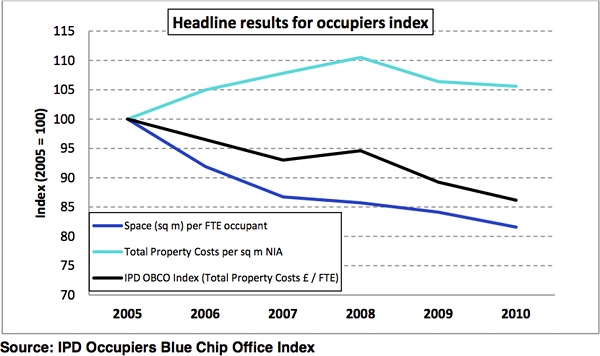by Brianna Crandall — February 6, 2012—Blue-chip (large corporate) companies occupying office space in the United Kingdom have managed to reduce the costs of office accommodation by 15% through cost control and improved space use, according to preliminary analysis by IPD, a global provider of objective commercial real estate performance analysis.
The IPD Occupiers Blue Chip Office Index, released as a consultative index in December 2011, pending a full index release in July 2012, has been created to provide occupiers, investors and suppliers with a credible time series (based on real data) which tracks how costs and the use of office space are changing. Information is drawn from both IPD’s database of U.K. rents and IPD’s Occupier benchmarking service.
According to IPD, average space per person has fallen, on average, by 4% per year, across all regions in the U.K. The company sees this as a product of both the rationalization of company portfolios and more efficient use of space, including the move to open-plan working. The average net interior area per person is now around 10 square meters per person.
“With most of organizations introducing some form of flexible working, we would expect reduced space demand to continue to be the main lever for cost control, which has wider implications for the U.K. office market,” says Glenn Corney, Global Product Manager for IPD Occupiers.
“Rental growth for offices has been largely flat for the last five years, and occupier demand is unlikely to rise amidst the current economic uncertainty and growth forecasts,” continues Corney. “Set against this the index numbers—which show occupiers require less space and are still looking to cut costs—imply even more difficulties for the growth of the office sector.”
“Office owners and managers need to take this into account,” encourages Corney. “Incentivization and active management have already been used to keep tenants, but this latest data shows they may need to do more to let space. Offices need to offer efficient floorplates and low running costs.”
Since 2005, total property costs have only increased by £23 per square meter (1.1% p.a.), well below inflation, which would have seen costs rise by almost 3% per year. Despite rates costs increasing by 29%, and operating costs (which include energy prices and maintenance costs) by 15%, falling rents have led to the small increase in total property costs. Total costs are therefore what matters, according to IPD, and concerns over future increases in the cost of energy are now clearly driving the demand for more energy efficient buildings.
Corney concluded, “In the last five years the fundamentals underlying total property costs have changed, with rents falling (by 7% as a proportion in five years) but operating costs rising. We have released this index because the property industry needs a barometer of how the costs of occupancy and patterns of space use are changing for major space users, especially in the current market.”





